A short comparative discussion between PVB, EVA and NovoGlass® TPU Film Interlayers for Smart Glass constructions.
 It has been an old dream to control the light that goes through the glass windows in such a way we can modulate the intensity of light inside our home rooms without the need of using stores or curtains, as we have been doing since past centuries.
It has been an old dream to control the light that goes through the glass windows in such a way we can modulate the intensity of light inside our home rooms without the need of using stores or curtains, as we have been doing since past centuries.
New technologies based on electrochromic or liquid crystal devices (LCDs) are smart technical options to the traditional ways of shadowing. These new devices will transform the mode of shadowing the interior of our houses in such a way that we will be able to modulate the intensity of light as per our preferences. The control of light intensity will be an old dream come true. And this is not just limited to control the light at the interior of our homes, but it will be used to increase the comfort inside the cabins of the new smart vehicles.
These electrochromic or liquid crystal devices should be laminated between two glasses that provide them the mechanical strength, robustness and the physical protection that these devices require.
Essentially these devices are made from different chemical materials with special physical properties that when activated by electrochemical reactions or physical molecular polarization allow the modulation of the light that goes through them.
The way that the glasses and the light control devices are joined is done normally by lamination processes in which different type of materials can be used. Obviously, the selected materials should fulfill some key properties to help the compound work and perform well. The main properties are the following:
- Should be highly transparent to not influence the effect of the light control devices
- Should be flexible and soft to wrap and protect the devices
- Should be easy processed to allow the integration of all the parts
- Should provide mechanical strength and robustness to the structure
- Should not change over time and degrade by UV radiation providing durability
The best suitable materials for that are PVB, EVA or TPUs. Which one is the best?. What are the drawbacks of them?.
It is the purpose of this article to briefly review the advantages or drawbacks of three type of glass film interlayers for the lamination of LCDs (Liquid Crystal Devices) or SPDs (Suspended Parcial Devices). We are talking about the three optical films that can be considered as interlayers for the construction of Smart Glass. More specifically the subject interlayers of our attention are: the PVB, the EVA and NovoGlass®SF TPU Films. We want to describe how each one of these interlayers affect and influence the manufacture and the reliability and robustness of these products.
The future of Smart Glass is here…
The implementation of Smart Glass to Architecture and Transportation is still an old dream to be converted into reality. It seems that this dream is closer to become a real thing very soon. But, what are we still missing to convert them into realities?. What is slowing down the appearance of these products?. What can we do to speed them up?.
It is not because is not a socially recognized need and it is not because they are a type of a “fancy and nice to have gadget”. Everybody likes and wishes to control and modulate the light intensity and the temperature inside buildings and vehicle cabins that protect us from the exterior environmental conditions with just one button touch away.
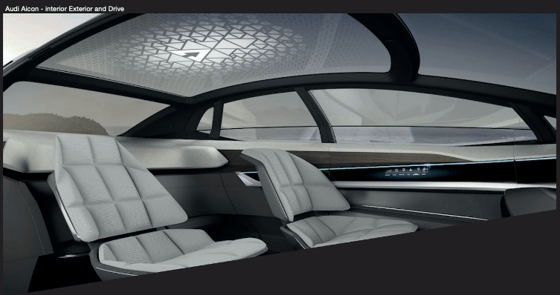
The functionality of these products is clearly accepted and expected to be enjoyed sooner than later. The Comfort Increase and Energy Savings, are two good reasons to go for them. Moreover, in the case of the protection of the interior of vehicles, the increase of the comfort of the drivers, will improve also their security. Another, and no less important added value to the above mentioned ones, is the reduction of our carbon footprint marks due to the reduction of Energy Consumption.
Knowing the great advantages that the use of Smart Glass will bring to us, we can clearly deduct that the long introduction time of these products should be related to technical impediments. Looking at the past we see that this technology was born around 20 years ago. Since then, it has been trying to growth with minor success. Different technologies have been competing for success. Along the time these products have been following different parallel technology paths going from electrochromic to oriented liquid crystal inside an acrylic matrix. It seems that this latest one is the one closer to make these products a reality. During all these times, several technical breakthroughs have been helping to bring this product to the successful reality that is almost today.
How the Film interlayers are contributing to help manufacture faster, cheaper and reduce rejections? and also, How they contribute, depending on their specific properties, to the reliability, robustness and the durability of these products?. These are the topics we want to cover.
We will go along our argumentation by answering the questions that almost everybody would have liked to answer.
Hopefully you can find this an interesting and useful article in a FAQ model.
Is a Smart Glass the same that an eGlass or a Switchable Glass or Light Control Glass?. Are there these titles referring the same or they have differences between them?.
There are no differences between all the terms. Their meaning is the same. All of them refer to the same type of products. Smart Glass, eGlass, Switchable Glass, Light Control Glass or their “windows versions”: Smart Windows, eWindows, Switchable Windows or Light Control Windows, all refer to the same electrical devices that change their transparency with voltage, modulating the visible light transmission that goes through them.
From now on, in our discussions, we will use the term Smart Glass to name this type of products in general.
How the Smart Glass devices are and how they exactly work?.
Smart Glass are glass-glass laminated structures in which the functional internal layer works as a light intensity modulator allowing to pass through an electrochromic or Liquid Crystal device.
Both type of systems are based on different technologies, but they are operated electrically in a similar way applying a different potentiality between two planar and transparent surfaces.
If you want to know how the electrochemical devices work we suggest you to visit the following web pages How electrochromic windows work?
The Liquid Crystal Devices work at the time that a voltage is applied internally between two parallel transparent conductive PET (PolyEsther) films. These two PET films play the role of an electrical condenser allowing to modulate the voltage between them. Depending on the voltage applied the “mass” of liquid Crystals can be partially or totally oriented due to its polarity properties, and consequently the intensity of light that goes through.
The Liquid Crystals are molecules that thanks to their special polarity properties can be oriented when a Voltage is applied. Depending on the voltage is possible to modulate their orientation and consequently the level of light transmission. If no voltage is applied the Liquid Crystals are not line arranged and as a consequence the light is fully blocked.
This property allows us to construct kind of intelligent devices and use them as a switchable curtain to help us modulate. In the case of Liquid Crystals, because of their polarity, they can be oriented, leaving the light to go through, or randomly disposed inside an acrylic net, blocking the light that goes through them.
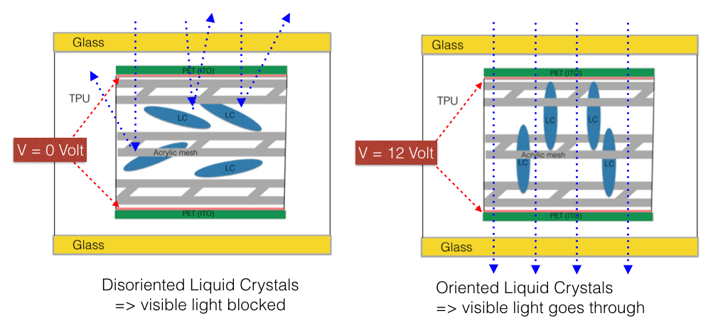
Around this type of products an interesting set of technologies are involved. In a simple way we can enumerate the following:
- The one that refers to the Liquid Crystals compositions, colors, functionalities and also their industrial manufacture (the “meat of the sandwich”)
- The Technology related to design and manufacture a semi rigid surface (a polymer material such as PET, PC or PMMA) into a transparent and conductive film. That is done applying by sputtering an ITO layer over the semirigid film, to provide it certain conductivity level. This is the system part that works as a switch and potential level control of the device (“the bread of the sandwich”)
- The dispersion of the LC inside of an Acrylic matrix that finally gets polymerized inside the PET-ITO layers and consequently homogeneously distributed inside the Semirigid films sandwich. The dispersion of the Liquid Crystals should be homogeneously distributed around the Acrylic matrix. (“the sauce of the sandwich”)
All of them together are the responsible of allowing the construction of reliable and robust Smart electrical devices that will allow us to modulate the light intensity that goes through them.
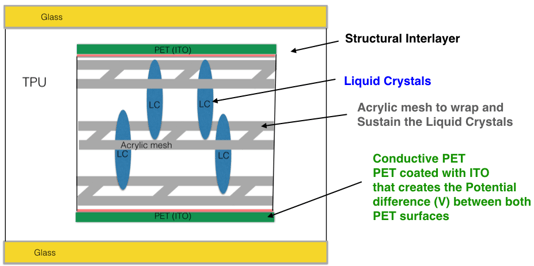
The lamination process between interlayers, constructing the windows.
The process of lamination of these electrical devices between two glass surfaces is also a critical step on the construction of efficient and robust structures.
For the lamination of these structures it is required to use a highly transparent and inert encapsulant material. Between the polymeric materials that fulfill these basic properties we can consider PolyVinylButyral (PVB), EthylenVinylAcetates (EVAs), and Thermoplastic PolyUrethanes (TPU).
All three have good optical properties but different mechanical and Chemical performance that influence their processing, compatibility and properties of the final Smart Glass products.
What are the main requirements of the interlayers used for Smart Glass lamination?.
All three interlayer fulfill the main critical property. All of them have good optical properties, being highly transparent. All three are also flexible and soft. Ok what respects to these two properties.
But they are not exactly the same regarding the processing conditions, mechanical robustness, UV resistance, yellowing, haze, optical distortions, humidity resistance, adhesion properties. Some important differences can be found when comparing them under these characteristics. These differences are the ones that determine their processing limitations, costs and weather durability conditions.
Why PVB is not the most convenient interlayer for Smart Glass construction?.
The PVB is a stiff optical interlayer that has been using for long time ago to laminate glass-glass structures in autoclave at 10 -12 bars at 130-140ºC.
Due to its stiffness, the PVB has poor adhesion to glass that is normally promoted by using high pressures to allow the physical adhesion to glass. To solve this “inconvenience” some PVB materials are “doped” with “plasticisers” which act as a softener (reducing the stiffness) and improving their intrinsic poor adhesivity (increasing the grip to other surfaces). The need to laminate with high pressures and the use of plasticizers are not good “things” for the switchable devices. The plasticisers migrate from the mass of polymer and generate product heterogeneities and instabilities of some of their main functions.
The PVB are also highly hydroscopic materials to which the humidity damages its weak adhesion properties to glass, promoting its de-lamination form glass.
Moreover, the PVBs have no adhesion to other semirigid materials as polycarbonates (PC), polymethylmetacrylates (PMMA) and polyesters (PET). They have no adhesion to the external substrates of the smart glass devices (the PETS).
All these facts make the PVB as a useless material for the lamination of smart devices.
What about the EVA interlayer?. Is the EVA a good film interlayer for Smart Glass?.
The EVAs are good candidates as a smart device interlayers because of their transparency and “softness” not to damage the switchable electrical devices. These are two good technical reasons in favor of EVA as a promising interlayer for Smart Glass.
Another factor that goes in favor of EVA is its low market price as a raw material. EVAs and PVBs have similar market prices that can make some people think that are the perfect encapsulant to be used instead of PVB.
But is the EVA the best and more convenient material to be used as film interlayer for the smart devices?.
To answer this question we need to know: What type of material EVA is?. What happens to it when it is processed?. How processing might affect the optical and mechanical properties of EVA?. and How the encapsulant properties affect the Smart Glass properties?.
What type of material is the EVA?.
The EVA is a copolymer material made from the ethylene molecules with vinyl acetate monomers inserted on them. The EVA molecules are mainly composed of ethylene molecules with randomly distributed vinyl acetate groups inside the molecular chains. The percentages of Acetate groups could be different at different percentages going from 10% to 35%.
The “crude” EVA is a very soft material with a very low melting point of 65ºC and low density, around 0,96 gr/cm3. Their mechanical properties are very poor in this state.
The EVAs need to be processed and transformed in order to have some acceptable mechanical properties to be used as interlayer of Smart Glass. The mechanical properties built up process consist on crosslinking the EVA molecules by chemical reaction, creating a kind of molecular chains net. Depending of how the process of “cooking” is done and the chemical reaction yield, the crosslinking might end up in a different levels of molecular crosslinking. It could be a 30….40, 60, 70, 80% crosslinking, while the rest of percentage is not linked and does not bring any mechanical property to the mass being a soft viscous material mixed up with the crosslinked part.
If you want to know How different are EVA and PVB, we suggest you to visit the following web pages: Glass Laminated Structures with EVA or PVB. A Comparison Analysis.
Are all EVAs the same?. Do they give all the same results?. Is the Optical Transmittance level the same regardless of their differences? Is there any relationship between Haze % (milky transparency) - and the lamination conditions?.
Not at all, not all EVAs are the same. As we just explained the EVAs might have different acetate contain in their molecules. This difference affects their reactivity and consequently their final mechanical and optical properties.
Once laminated, depending on how the process goes, the reaction might end up with different crosslinking values. So it is possible, besides starting from the same material, to finish the process with films with different optical transparencies, with different haze values (white milky transparency) and also different mechanical properties. The level of cross linking affects the transparency of the film as its mechanical properties. The higher the cross linking the higher the transparency and better mechanical response. But even at their highest cross linking values some EVAs can not reach high levels of transparency, showing a "milky" transparency. This defect has been tried to convert into an advantage by using them as a LCDs (Liquid Crystal Displays) devices.
So since the optical and mechanical properties depend on the processing conditions, the possibility to end up with the same and homogeneous interlayer is a real challenge. Depending on the transformation results it is possible to end up from transparent to milky (high haze) interlayer. The level of transparency depends on the efficiency of the cross linking process and the final cross linking % values. To have a good optical result you should do a good job starting from a good raw material.
How is the lamination process with EVA?. How the lamination process might affect the Quality of the Smart Glass?.
As it has been explained during the lamination process, the EVA gets transformed into a thermoset material, at the time it gets cross linked. The cross linking process is a chemical transformation that is activated and catalyzed by a peroxide. The peroxides should be homogeneously distributed in the mass of EVA and requires to be activated normally at 130 -140ºC. The lamination conditions are critical in order to achieve a good product.
But it happens that the organic switchable devices (either electrochromic or polarized liquid crystals ones), cannot sustain more than 120ºC for long time without suffering degradation. This key requirement is a big drawback for the use of EVA on the lamination of Smart Glass.
Since there is the need to raise up the temperature to 130ºC to complete the cross linking reaction of EVA, while the lamination temperature should not go above 120ºC, the lamination process has to be kept at 120ºC for a few hours (a long time) to complete it 100%. Otherwise, if the reaction is not fully completed, some remaining and non activated catalyst remains in “latent status” mixed in the mass of EVA. This catalyst stays as a contamination inside the mass of polymer and can be activated at any time (when the conditions are reached) without any control and start some side reactions that end up with the degradation of the interlayer. Normally the degradation can be seen in the form of de-lamination, yellowing and functionality loss of the switchable device.
How to know that the reaction is completed?. We can help you on that. We can explain How the process goes and How to measure the efficiency of your reactions. Feel free to let us know your interest on that.
Moreover during the cross linking process the EVA changes its viscosity from very low viscosities to a slightly higher ones. During this process, and until the final level of cross linked is achieved, due its low viscosity, the mass of EVA flows from the edges of the laminate away of the structure. This phenomena generates changes in thickness in the interlayer surface, losing planarity and consequently generating different type of optical distortions, such as edges dichroism. See below photos.
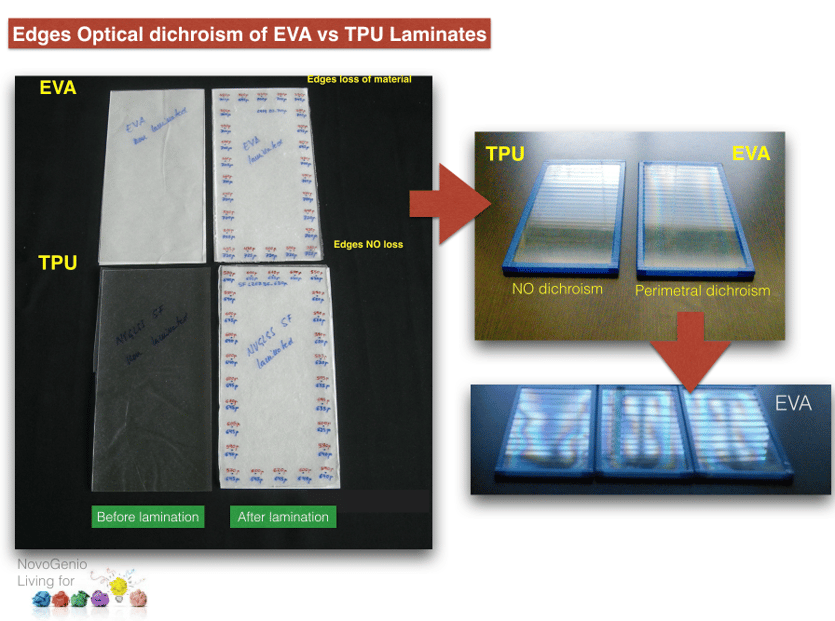
What about the mechanical properties of the EVA laminates?. What are the mechanical properties differences compared to TPU NovoGlass® SF Grades?.
The main mechanical differences between EVA and TPU are not just dependent of their own material characteristics, in the case of EVA they strongly depend also on the reaction completion.
Comparing materials, we clearly see that the “cooked” EVA has a mechanical behavior like the one that is represented in (B) graph below. Its elasticity is someway limited after certain effort from which it looses its capacity to recover. In the case of TPUs their almost unlimited capacity to recover make them strong materials very useful for very demanding applications such the ones required in Aerospace and Ballistic Resistant Glass Structures (BRGs).Their flexible and viscous properties make them as the ideal materials as eGlass Encapsulants.
In the case of EVA, the fact that their mechanical properties are dependent on the “cooking” process and conditions, the mechanical homogeneity of the laminates might suffer from variability yielding heterogeneous results between pieces and also in the same piece.
The TPU, being a special thermoplastic material, is an easy going material that can be easily processed under low pressures and temperatures.
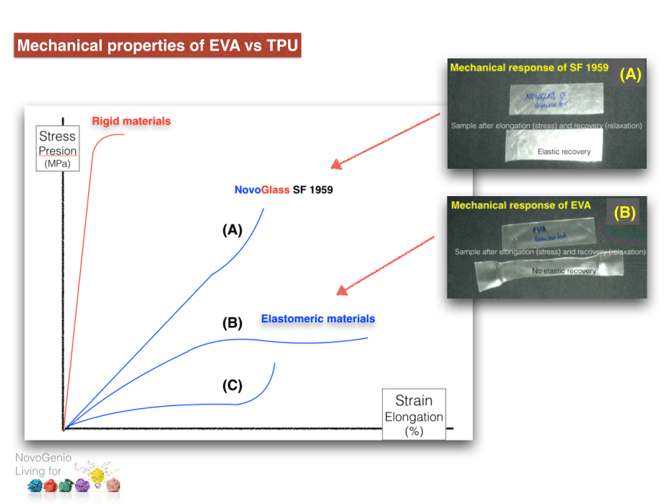
Is the EVA sensitive to Solar radiation?. How Solar radiation can affect its optical and mechanical properties?. Is that the reason why Smart glass products have not been used in exterior applications?.
During the last 20 years, these type of structures have been constructed with EVA. But if we look around we will see that these type of products, besides their longevity in the Architectural market, they have not become popular in Architecture and not extended to other markets such as transportation vehicles. For many years, the main type of application has been for the construction of glass-glass hazy white panels to separate spaces and rooms in the interiors of buildings such as meeting rooms, bathrooms, bedrooms, etc. Surprisingly these type of smart structures have not been used for exterior Architectural applications. Their uses have not been able to move to outside of buildings. Knowing and realizing that, the following questions come up: Why is that?. Why we cannot find them in the exteriors?.
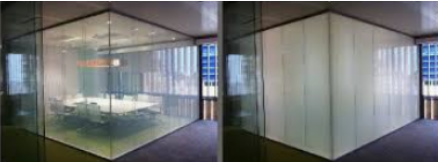
We can find the reason of that if we look at the sensitivity of the EVA to solar radiation.
The EVA due to its molecular composition is sensitive to sun UV radiation, and for this reason we formulate EVA with UV stabilizers. When EVA is exposed to sun radiation, especially in Summer time and anytime in certain parts of the world, the UV range of solar radiation can “burn the molecules” causing degradation and forming acetic acid (for more info click the links: About solar EVA degradation process, Identifying early-stage discoloration in EVA encapsulants,). These acetic acid molecules that come from the degradation of EVA can attack all type of electronic devices and metallic connexions causing severe damages and even destroying them. This process ends up in strongly EVA yellowing de-coloration. This is a well-know problem that happens to all solar panels between 7 and 14 years after use.
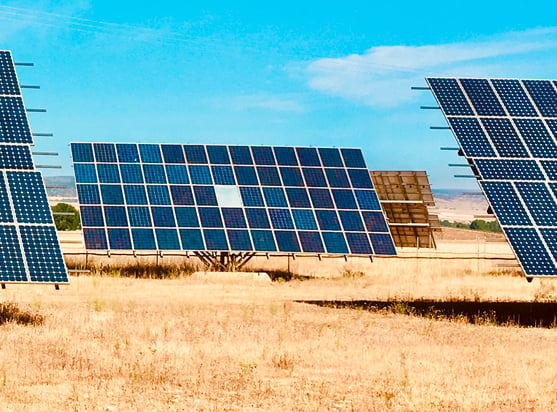
The TPU, by contrary, due to its molecular composition is not so sensitive to solar radiation and it is almost not affected by UV solar radiation. Besides, we also protect the TPU with some special UV stabilizers in order to enforce their solar radiation resistance.
How easy is it to recycle EVA?. Can we apply for recycling procedures with damaged or outdate Smart Glass?.
From a recycling point of view, the EVA being a thermoset, makes the laminates not recyclable products. That means that if you would like to recover either the glass or the switching device from a lamination upset, you cannot do it. The only way to recover the glass is to burn it all the structure to degrade all the organic parts, that means the EVA and the switchable electrical device.
A completely different situation you will have if you use TPU instead of EVA as interlayer. In that case, being the TPU a thermoplastic material, you have the possibility to disassemble the parts with temperature without the need of burning it.
Why TPU NovoGlass® SF interlayer is the most convenient interlayer to laminate Light Control Glasses?.
As it has been disclosed answering the previous questions above, the TPU interlayers are the ones that yield the best results in terms of:
-
-
-
They are extremely high transparent with haze values below 0,5% and no milky or yellowing aspect.
-
They are flexible and soft to wrap the devices thanks to their elastic and viscous compositions
-
It is by difference the easiest processing interlayer, allowing the integration of all the parts under mild processing conditions. Their special thermoplastic properties facilitate the encapsulation of the switchable devices without damaging them. No cross linking process is needed!!
-
They provide the best mechanical strength and robustness properties to the structure in a wide range of temperatures of operation between - 30ºC to 80ºC
-
They do not change over time and degrade by UV radiation providing durability because of their molecular composition and solar radiation stability. They are excellent materials to be used in exterior applications.
-
Their use warranties the recyclability of the Smart Glass laminates
-
-
If you need more information, please don't hesitate to let us know and we will contact you ! .
March 13, 2024